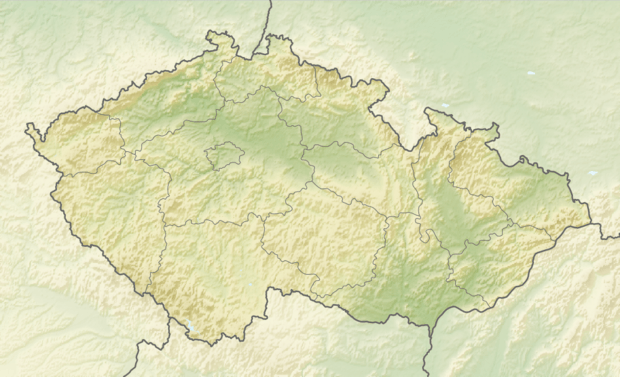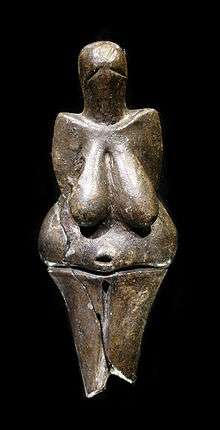Dolní Věstonice
Dolní Věstonice (German: Unterwisternitz) is a small village in the South Moravian Region of the Czech Republic. It is known for a series of ice age archaeological sites in the area, including the oldest permanent human settlement ever found by archaeologists in the entire world.[1] These sites were used by mammoth hunters, and finds include a triple burial and the Venus of Dolní Věstonice.
- For information on the Dolní Věstonice archaeological site, please see Dolní Věstonice.
Dolní Věstonice | |
|---|---|
Village | |
 Dolní Věstonice, 2007 | |
 Flag  Coat of arms | |
 Dolní Věstonice Location in the Czech Republic | |
| Coordinates: 48°53′14″N 16°38′38″E | |
| Country | Czech Republic |
| Region | South Moravian |
| District | Břeclav |
| First Mentioned | 1312 |
| Area | |
| • Total | 8.76 km2 (3.38 sq mi) |
| Elevation | 174 m (571 ft) |
| Population (2014) | |
| • Total | 322 |
| • Density | 37/km2 (95/sq mi) |
| Time zone | UTC+1 (CET) |
| • Summer (DST) | UTC+2 (CEST) |
| Postal code | 691 29 |
| Website | www |
Although prehistoric artifacts have been found in the area for some time, formal archaeological research started in 1924. The village became a target for tourists interested in archeology, wine, architecture or traditional costumes.
History
Approximately 25,000 years ago, during the Upper Paleolithic period of the Stone Age, a small settlement consisting of huts built with rocks and mammoth bones was founded on the site of what is now Dolní Věstonice. This is the oldest permanent human settlement that has ever been found by archaeologists.[1] Numerous other archaeological discoveries point to extensive human habitation of the area in prehistoric times.
During the Great Moravia period, which lasted between the 9th and 10th centuries, a small fortress was built here. The first known mention of the place in written documents is from 1312. During the 13th century the place became inhabited by German colonists. In 1460 it received city rights. From the beginning of the 16th century Habaners (Habáni, members of anabaptist sects expelled from German lands and Switzerland) settled here. They were expelled again in 1622.
Until 1918, the village was part of the Austrian monarchy (Austria side after the compromise of 1867), in the NIKOLSBURG district, one of the 34 Bezirkshauptmannschaften in Moravia.[2]
A post-office named UNTER-WISTERNITZ was opened in 1869.
In 1938, it was occupied by the Nazi army as one of the municipalities in Sudetenland. The German speaking population was expelled in 1945 (see the Beneš decrees) and replaced by Czech settlers.
Population development
Before World War II the village was ethnically German speaking:
| Census year | Population | Ethnicity of inhabitants | ||
|---|---|---|---|---|
| year | German | Czechs | other | |
| 1793 | 630 | – | – | |
| 1836 | 766 | – | – | – |
| 1869 | 779 | – | – | – |
| 1880 | 752 | 742 | 0 | 10 |
| 1890 | 826 | 812 | 1 | 13 |
| 1900 | 842 | 835 | 6 | 1 |
| 1910 | 771 | 768 | 3 | 0 |
| 1921 | 686 | 658 | 10 | 17 |
| 1930 | 688 | 642 | 36 | 10 |
| 1939 | 633 | – | – | – |
References
- Stuart, Gene S. (1979). "Ice Age Hunters: Artists in Hidden Cages". Mysteries of the Ancient World. National Geographic Society. p. 19.
- Die postalischen Abstempelungen auf den österreichischen Postwertzeichen-Ausgaben 1867, 1883 und 1890, Wilhelm KLEIN, 1967
- Historický místopis Moravy a Slezska v letech 1848–1960, sv.9. 1984
